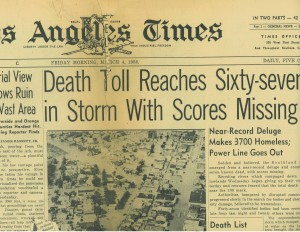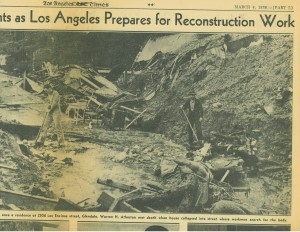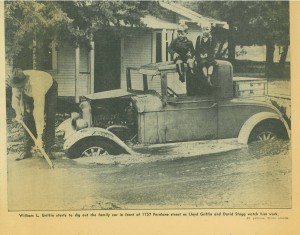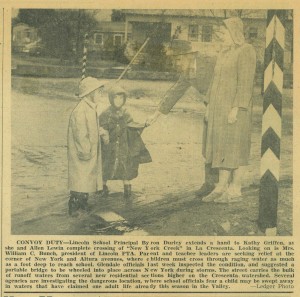The previous three parts of this series showed the consequences of a very particular combination of earth, wind, fire and water in the hills north of downtown Los Angeles. Â The massive devastation caused by the 1933/1934 New Year’s flood was certainly a wake-up call not only for the residents but for local authorities. Well not really. Â The wake-up call should’ve come long before.
The whole Los Angeles basin had actually at one time been a great trough which was filled and leveled by debris falling off the San Gabriel Mountains. Â Floods composed of water, mud and debris had been coming into the area for eons. Â The authorities knew it and understood the problem long before the great New Year’s flood. Â In fact, flood control engineers had been trying to take action for many years prior to the flood in 1934. In most cases local referenda to pay for the construction of dams and flood control channels had been voted down by the populace. Â What’s more, the authorities had no legal power to stop the building of residences in flood prone areas in the foothills north of Los Angeles.
Only a few months after Franklin Delano Roosevelt came president he established by Executive Order an agency known as the Federal Emergency Administration of Public Works, which in one of its first acts rejected the application from LA County officials for grants and loans of almost $35 million for flood control efforts. Â This was just months before the great flood. Â The LA County Board of Supervisors placed on the ballot a local bond measure for about $25 million for flood control efforts in the fall of 1933. Â The measure was defeated by about 4%. Â This left but 15% of the River and Stream channels with reinforced levies or dam controls.
At the same time the people were voting down measures to fund flood control, building in the foothills communities continued at a steady rate. Â It was not until the summer of 1935 that depression era programs like the WPA (Works Progress Administration), utilized with federal funding and under the control of the Corps of Engineers began serious work on flood control in Los Angeles County.
The Federal Flood Control Act of 1936 not only gave funding for additional projects but additionally put the work firmly under the auspices of a US Army Corps of Engineers. Unfortunately, work was not nearly complete in 1938 when the most devastating flood in LA County history occurred.  The “official†loss of life was even greater than in the 1934 flood.
This however was not the end of the problem.  Although the effects of those “perfect storm†of events we discussed earlier in this series were mitigated, they could not be completely halted as these photos and headlines from Rusty’s archives indicate.
Certainly by the 1960’s however we would have things under control? Â Again, unfortunately not, as additional floods in the 60’s and 70’s would graphically demonstrate.
In the final two sections of this series we will lay bare the recent devastating events that led to the distruction of several houses and the damage to many more from the same perfect storm of factors in the hills above the Los Angeles basin.  We will divulge the “secret” conditions (apparently unknown by hundreds of people) that keep Rusty’s homestead from this type of devastation.  We’ll even discuss how the most recent floods were not only predictable, but perhaps largely preventable with one simple decision.  In the final installment, we’ll predict the future and exactly who will win and who will lose in the battle against the mud floods!




0 comments ↓
There are no comments yet...Kick things off by filling out the form below.
Leave a Comment